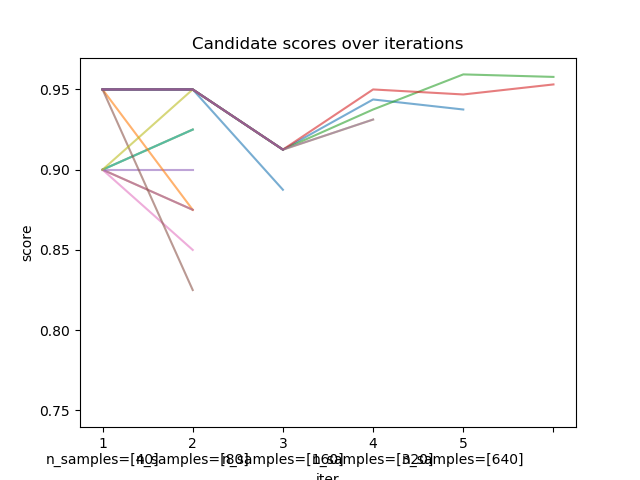Note
Click here to download the full example code
Successive Halving¶

import pandas as pd
from sklearn import datasets
import matplotlib.pyplot as plt
from sklearn.ensemble import RandomForestClassifier
from scipy.stats import randint
import numpy as np
from dabl.search import RandomSuccessiveHalving
rng = np.random.RandomState(0)
X, y = datasets.make_classification(n_samples=700, random_state=rng)
clf = RandomForestClassifier(n_estimators=20, random_state=rng)
param_dist = {"max_depth": [3, None],
"max_features": randint(1, 11),
"min_samples_split": randint(2, 11),
"bootstrap": [True, False],
"criterion": ["gini", "entropy"]}
rsh = RandomSuccessiveHalving(
estimator=clf,
param_distributions=param_dist,
budget_on='n_samples', # budget is the number of samples
max_budget='auto', # max_budget=n_samples
n_candidates='auto', # choose n_cdts so that last iter exhausts budget
cv=5,
ratio=2,
random_state=rng)
rsh.fit(X, y)
results = pd.DataFrame(rsh.cv_results_)
results['params_str'] = results.params.apply(str)
mean_scores = results.pivot(index='iter', columns='params_str',
values='mean_test_score')
ax = mean_scores.plot(legend=False, alpha=.6)
r_i_list = results.groupby('iter').r_i.unique()
labels = ['{}\nn_samples={}'.format(i, r_i_list[i])
for i in range(rsh.n_iterations_)]
ax.set_xticklabels(labels)
ax.set_title('Candidate scores over iterations')
ax.set_ylabel('score')
plt.show()
Total running time of the script: ( 0 minutes 9.279 seconds)